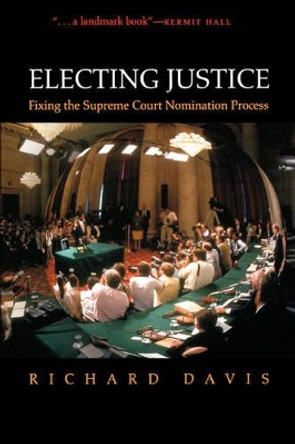Description
This book examines whether Supreme Court justices are becoming more publicity-conscious and why that might be happening.
About the Author
Richard Davis is a professor of political science at Brigham Young University. He is the author or co-author of several books on media and American politics, including Electing Justice: Fixing the Supreme Court Nomination Process (2005), Decisions and Images: The Supreme Court and the Press (1994), The Web of Politics (1999), Campaigning Online (2003, with Bruce Bimber) and New Media and American Politics (1998, with Diana Owen). He is chair of the Political Communication section of the American Political Science Association.
Reviews
'Supreme Court justices like to cultivate an image of being aloof and apart from politics and the media. Richard Davis' eye-opening book offers ample proof that to varying degrees, justices have engaged with journalists and politicians throughout American history. The Court's lofty mystique will never be the same.' Tony Mauro, Supreme Court correspondent for The National Law Journal, has covered the Supreme Court for more than 30 years
'With the Justices now regularly writing books, publicly debating constitutional issues, and sitting for media interviews, Justices and Journalists could not be more timely. It's a path-breaking study that will generate discussion, debate, and research over the questions of how and why Justices 'go public' - and whether they should in the first place.' Lee Epstein, Henry Wade Rogers Professor, Northwestern University
'While 'going public' has rarely been seen as a strategic option for Supreme Court justices wishing to reveal themselves, in Justices and Journalists Richard Davis explains the increasing willingness of contemporary justices to do just that. In his fascinating account, Davis combines historical study with empirical analysis to reveal the panoply of motivations, personal, political and institutional, that have altered significantly judicial norms into the 21st century. This is rich scholarly work that will plant the seeds for continuing research while offering countless examples ripe for our classrooms. By focusing largely on the justices themselves, Davis leaves the reader with a better understanding of the seeming irony that, as most studies of media coverage of the Supreme Court have revealed, while coverage of the Court, per se, continues to dissipate, the justices, themselves, continue to be more newsworthy.' Elliott Slotnick, Ohio State University
'Davis gives us a look into how the justices' use of the press has changed. In a way, the curtain is pulled, removing the Court's mystique and anonymity. His research makes a valuable contribution to our understanding of the relationship between the justices and the press. This book is appropriate for journalists, lawyers, historians, and scholars and graduate students in mass communications, the judicial process, and political science.' Terri L. Towner, Oakland University
'... many of the chapters include useful sections relating to the often-thorny issue of cameras and digital technology in courtrooms, and taken together these chapters offer an unusually broad snapshot of how those practices have developed in a wide range of jurisdictions.' Richard Jones, Entertainment Law Review
Book Information
ISBN 9780521704663
Author Richard Davis
Format Paperback
Page Count 264
Imprint Cambridge University Press
Publisher Cambridge University Press
Weight(grams) 360g
Dimensions(mm) 228mm * 152mm * 15mm










